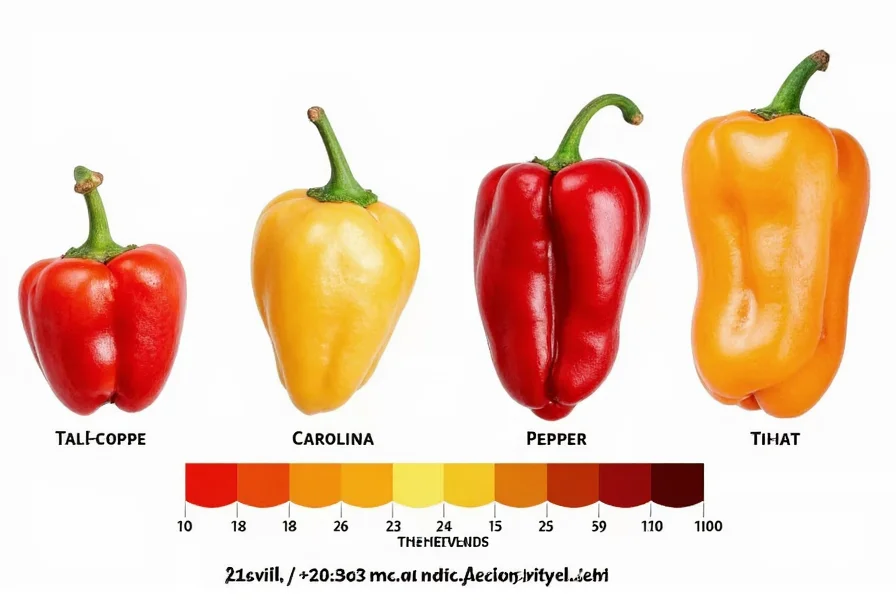Understanding pepper heat levels is essential for cooks, gardeners, and spice enthusiasts. The Scoville scale remains the definitive measurement system for chili pepper pungency, despite newer scientific methods. This comprehensive guide explains how the scale works, lists common peppers by heat level, and provides practical information for safely working with spicy ingredients.
How the Scoville Scale Works
Wilbur Scoville's original 1912 method, called the Scoville Organoleptic Test, involved human tasters diluting chili extracts with sugar water until the heat became undetectable. The degree of dilution determined the Scoville rating. A pepper rated at 5,000 SHU required dilution of 1 part pepper extract to 5,000 parts sugar water before the heat disappeared.
Modern laboratories now use High-Performance Liquid Chromatography (HPLC) to precisely measure capsaicinoid concentration, then convert these measurements to Scoville units. This scientific approach eliminates human subjectivity while maintaining the familiar SHU scale that consumers understand.
Pepper Heat Level Chart
| Pepper Variety | Scoville Heat Units (SHU) | Heat Level Classification |
|---|---|---|
| Bell Pepper | 0 SHU | Mild |
| Pepperoncini | 100-500 SHU | Mild |
| Jalapeño | 2,500-8,000 SHU | Medium |
| Serrano | 10,000-23,000 SHU | Hot |
| Habanero | 100,000-350,000 SHU | Very Hot |
| Ghost Pepper (Bhut Jolokia) | 800,000-1,041,427 SHU | Extremely Hot |
| Carolina Reaper | 1,400,000-2,200,000 SHU | Superhot |
This comprehensive pepper Scoville scale chart shows the dramatic range of heat levels across different chili varieties. Note that SHU values represent ranges because growing conditions, soil composition, and climate significantly affect capsaicin production. A jalapeño grown in optimal conditions might reach 8,000 SHU, while the same variety in less ideal conditions might only reach 2,500 SHU.

The Science Behind Pepper Heat
Capsaicin, the primary capsaicinoid in chili peppers, triggers heat receptors in your mouth and skin. These receptors, called TRPV1, evolved to detect actual heat and physical abrasion. When capsaicin binds to these receptors, your brain interprets the signal as burning—even though no actual thermal damage occurs.
Pepper heat serves an evolutionary purpose: deterring mammals from eating the fruit while allowing birds (which don't feel capsaicin's effects) to consume and disperse the seeds. This explains why wild chili peppers tend to be hotter than cultivated varieties—humans have selectively bred milder peppers over centuries.
Practical Applications of the Scoville Scale
Chefs and home cooks use the pepper heat rating system to select appropriate peppers for recipes. Understanding Scoville units helps prevent culinary disasters when substituting one pepper for another. For example, replacing jalapeños (2,500-8,000 SHU) with habaneros (100,000-350,000 SHU) would increase the heat level by 12-140 times!
When working with superhot peppers (350,000+ SHU), take proper precautions:
- Wear gloves to prevent skin irritation
- Avoid touching your face, especially eyes
- Work in well-ventilated areas (capsaicin becomes airborne when cutting)
- Have dairy products nearby to neutralize heat (milk, yogurt, sour cream)

Common Misconceptions About Pepper Heat
Several myths persist about the Scoville scale and pepper heat. Many believe the seeds contain the most heat, but capsaicin primarily concentrates in the white pith (placenta) surrounding the seeds. Removing seeds alone won't significantly reduce heat.
Another misconception: water effectively cools your mouth after eating hot peppers. Water actually spreads capsaicin around your mouth. Dairy products work better because casein proteins bind to capsaicin and help wash it away.
The Scoville scale also doesn't account for heat duration or quality. Some peppers deliver immediate, sharp heat that fades quickly (like cayenne), while others produce a slow-building, long-lasting burn (like habaneros). This subjective experience isn't captured by SHU measurements alone.
Understanding Scoville Heat Unit Variability
Natural variation affects pepper heat levels significantly. The same pepper variety can vary by 50% or more in SHU depending on:
- Soil nutrients and moisture levels
- Sun exposure and temperature fluctuations
- Plant maturity at harvest time
- Genetic differences between individual plants
Commercial producers often blend peppers from multiple sources to maintain consistent heat levels in products like hot sauces. Home gardeners should expect variation between plants, even when growing from the same seed packet.
Frequently Asked Questions
What is the hottest pepper on the Scoville scale?
The Carolina Reaper currently holds the Guinness World Record as the hottest pepper, with an average Scoville rating of 1.6 million SHU and peaks exceeding 2.2 million SHU. However, new superhot varieties continue to be developed through selective breeding.
How can I reduce the heat of a pepper while cooking?
To reduce pepper heat, remove the white placental tissue (where most capsaicin concentrates) before cooking. Adding acidic ingredients like lemon juice or vinegar can also help neutralize some heat. For finished dishes that are too spicy, incorporate dairy products, sugar, or starches which bind to capsaicin and reduce its intensity.
Why do some people tolerate spicy food better than others?
Spice tolerance develops through repeated exposure. Regular consumption of capsaicin temporarily desensitizes TRPV1 receptors. Genetic factors also play a role—some people naturally have more heat receptors. Cultural exposure from childhood significantly influences adult spice tolerance levels.
Can you measure Scoville units at home?
Accurate Scoville measurement requires laboratory equipment. Home testing methods like the milk dilution test provide rough estimates but lack scientific precision. Commercial labs use High-Performance Liquid Chromatography (HPLC) to measure capsaicin concentration, then convert to Scoville units using standardized formulas.











 浙公网安备
33010002000092号
浙公网安备
33010002000092号 浙B2-20120091-4
浙B2-20120091-4